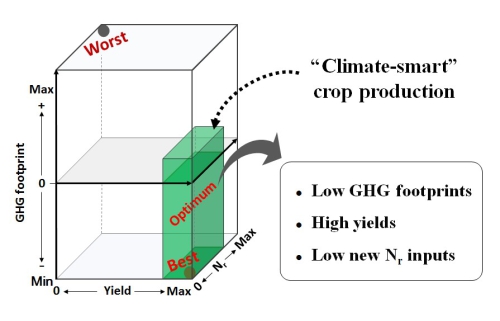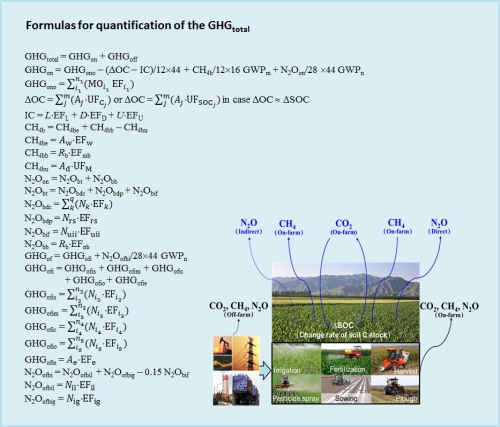Quantifying the Greenhouse Gas Footprint of Crop Cultivation
Date:2017-12-06
"Climate-smart” crop cultivation, characterized by a low greenhouse gas (GHG) footprint, low synthetic nitrogen consumption, and simultaneously high yields (Figure 1), is an approach in agriculture for implementing the Paris Agreement as part of mitigating climate change. The GHG footprint is an index used to indicate the climate change impact potential exerted by crop production. It is therefore crucial to accurately quantify the GHG footprints of crop cultivation systems. However, severe problems or drawbacks in the quantification of GHG footprints still exist, which has limited the applicability of the GHG footprint in crop cultivation.

Fig. 1 A “climate-smart” crop cultivation system is characterized by a low greenhouse gas (GHG) footprint, low consumption of synthetic nitrogen (i.e., new Nr), and simultaneously high crop yields. (Image by ZHENG Xunhua)
To solve these problems or drawbacks, in a recently published study in Atmospheric and Oceanic Science Letters, Prof. ZHENG Xunhua and her coauthor from the Institute of Atmospheric Physics, Chinese Academy of Sciences, proposed a generic methodological framework to quantify the GHG footprints of crop cultivation systems free from grazing (Figure 2).

Fig. 2 Formulas for calculating the life-cycle total net greenhouse gas emission (GHGtotal), which is crucial for accurately quantifying the GHG footprint from a crop cultivation system (Image by ZHENG Xunhua)
"The current framework can more completely take into account the direct/indirect contributors in quantifying the GHG emissions and/or uptakes within a crop-production life cycle. In addition, it provides example values of some GHG emission factors while emphasizing the combination of direct measurements and model simulations in determining other key parameters,” explains ZHENG. “And we hope that this methodological framework can support different studies to obtain comparable values of GHG footprints, which may be the key parameters for determining the green value added tax of foods in implementing the Paris Agreement.”
Citation: Zheng, X., and S. Han. 2018. “A generic methodological framework for accurately quantifying greenhouse gas footprints of crop cultivation systems.” Atmospheric and Oceanic Science Letters, 11, in press.
Media Contact: Ms. LIN Zheng, jennylin@mail.iap.ac.cn
